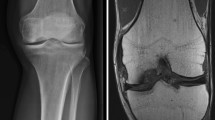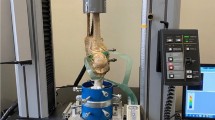Abstract
Purpose
The influence of basal graft support combined to early loading following an osteochondral autograft procedure is unclear. It was hypothesized that bottomed grafts may allow for early mobilization by preventing graft subsidence and leading to better healing.
Methods
Osteochondral autografts were press fitted in the femoral condyles of 24 sheep (one graft per animal). In the unbottomed group (n = 12), a gap of 2 mm was created between graft and recipient bone base. In the bottomed group (n = 12), the graft firmly rested on recipient bone. Animals were allowed immediate postoperative weightbearing. Healing times were 3 and 6 months per group (n = 6 per subgroup). After killing, histological and histomorphometric analyses were performed.
Results
Unbottomed grafts at 3 months showed significantly more graft subsidence (P = 0.024), significantly less mineralized bone (P = 0.028) and significantly worse cartilage and subchondral bone plate healing (P = 0.034) when compared to bottomed grafts. At 6 months, no differences were seen. Compared to the native situation, unbottomed grafts showed significantly more graft subsidence (P = 0.024), whereas bottomed grafts did not. Cystic lesions were seen in both groups. Osteoclasts were closely related to the degree of bone remodelling.
Conclusion
In the animal model, in the case of early loading, bottomed osteochondral autografts have less chance of graft subsidence. Evident subsidence negatively influences the histological healing process. In the osteochondral autograft procedure, full graft support should be aimed for. This may allow for early mobilization, diminish graft subsidence and improve long-term integration.



Similar content being viewed by others
References
Bobic V (1996) Arthroscopic osteochondral autograft transplantation in anterior cruciate ligament reconstruction: a preliminary clinical study. Knee Surg Sports Traumatol Arthrosc 3:262–264
Cox LG, Lagemaat MW, van Donkelaar CC et al (2011) The role of pressurized fluid in subchondral bone cyst growth. Bone 49:762–768
Diduch DR, Chhabra A, Blessey P, Miller MD (2003) Osteochondral autograft plug transfer: achieving perpendicularity. J Knee Surg 16:17–20
Duchow J, Hess T, Kohn D (2000) Primary stability of press-fit-implanted osteochondral grafts. Influence of graft size, repeated insertion, and harvesting technique. Am J Sports Med 28:24–27
Frenkel SR, Bradica G, Brekke JH et al (2005) Regeneration of articular cartilage–evaluation of osteochondral defect repair in the rabbit using multiphasic implants. Osteoarthr Cartil 13:798–807
Frenkel SR, Di Cesare PE (1999) Degradation and repair of articular cartilage. Front Biosci 15(4):D671–D685
Haklar U, Tuzuner T, Uygur I et al (2008) The effect of overlapping on the primary stability of osteochondral grafts in mosaicplasty. Knee Surg Sports Traumatol Arthrosc 16:651–654
Hangody L, Fules P (2003) Autologous osteochondral mosaicplasty for the treatment of full-thickness defects of weight-bearing joints: ten years of experimental and clinical experience. J Bone Jt Surg Am 85-A (Suppl2):25–32
Huang FS, Simonian PT, Norman AG, Clark JM (2004) Effects of small incongruities in a sheep model of osteochondral autografting. Am J Sports Med 32:1842–1848
Imade S, Kumahashi N, Kuwata S et al (2012) Effectiveness and limitations of autologous osteochondral grafting for the treatment of articular cartilage defects in the knee. Knee Surg Sports Traumatol Arthrosc 20:160–165
Kiss MO, Levasseur A, Petit Y et al (2012) Axial load-bearing capacity of an osteochondral autograft stabilized with a resorbable osteoconductive bone cement compared with a press-fit graft in a bovine model. Am J Sports Med 40:1046–1052
Kleemann RU, Schell H, Thompson M et al (2007) Mechanical behavior of articular cartilage after osteochondral autograft transfer in an ovine model. Am J Sports Med 35:555–563
Kock NB, Hannink G, van Kampen A et al (2011) Evaluation of subsidence, chondrocyte survival and graft incorporation following autologous osteochondral transplantation. Knee Surg Sports Traumatol Arthrosc 19:1962–1970
Kock NB, Smolders JM, Van Susante JL et al (2008) A cadaveric analysis of contact stress restoration after osteochondral transplantation of a cylindrical cartilage defect. Knee Surg Sports Traumatol Arthrosc 16:461–468
Kock NB, Van Susante JL, Buma P et al (2006) Press-fit stability of an osteochondral autograft: influence of different plug length and perfect depth alignment. Acta Orthop 77:422–428
Koh JL, Kowalski A, Lautenschlager E (2006) The effect of angled osteochondral grafting on contact pressure: a biomechanical study. Am J Sports Med 34:116–119
Kordas G, Szabo JS, Hangody L (2005) The effect of drill-hole length on the primary stability of osteochondral grafts in mosaicplasty. Orthopedics 28:401–404
Kordas G, Szabo JS, Hangody L (2006) Primary stability of osteochondral grafts used in mosaicplasty. Arthroscopy 22:414–421
Lintz F, Pujol N, Pandeirada C et al (2011) Hybrid fixation: evaluation of a novel technique in adult osteochondritis dissecans of the knee. Knee Surg Sports Traumatol Arthrosc 19:568–571
Mainil-Varlet P, Rieser F, Grogan S et al (2001) Articular cartilage repair using a tissue-engineered cartilage-like implant: an animal study. Osteoarthr Cartil 9(Suppl A):S6–S15
Makino T, Fujioka H, Terukina M et al (2004) The effect of graft sizing on osteochondral transplantation. Arthroscopy 20:837–840
Nakagawa Y, Suzuki T, Kuroki H et al (2007) The effect of surface incongruity of grafted plugs in osteochondral grafting: a report of five cases. Knee Surg Sports Traumatol Arthrosc 15:591–596
Nosewicz TL, Reilingh ML, Van Dijk CN et al (2012) Weightbearing ovine osteochondral defects heal with inadequate subchondral bone plate restoration: implications regarding osteochondral autograft harvesting. Knee Surg Sports Traumatol Arthrosc 20:1923–1930
Orth P, Zurakowski D, Wincheringer D et al (2012) Reliability, reproducibility, and validation of five major histological scoring systems for experimental articular cartilage repair in the rabbit model. Tissue Eng Part C Methods 18:329–339
Pearce SG, Hurtig MB, Clarnette R et al (2001) An investigation of 2 techniques for optimizing joint surface congruency using multiple cylindrical osteochondral autografts. Arthroscopy 17:50–55
Radin EL, Rose RM (1986) Role of subchondral bone in the initiation and progression of cartilage damage. Clin Orthop Relat Res 213:34–40
Recht MP, Goodwin DW, Winalski CS, White LM (2005) MRI of articular cartilage: revisiting current status and future directions. AJR Am J Roentgenol 185:899–914
Recht MP, Kramer J (2002) MR imaging of the postoperative knee: a pictorial essay. Radiographics 22:765–774
Reddy S, Pedowitz DI, Parekh SG et al (2007) The morbidity associated with osteochondral harvest from asymptomatic knees for the treatment of osteochondral lesions of the talus. Am J Sports Med 35:80–85
Roodman GD (1996) Advances in bone biology: the osteoclast. Endocr Rev 17:308–332
Rudert M (2002) Histological evaluation of osteochondral defects: consideration of animal models with emphasis on the rabbit, experimental setup, follow-up and applied methods. Cells Tissues Organs 171:229–240
Sanders TG, Mentzer KD, Miller MD et al (2001) Autogenous osteochondral “plug” transfer for the treatment of focal chondral defects: postoperative MR appearance with clinical correlation. Skeletal Radiol 30:570–578
Schell H, Lienau J, Epari DR et al (2006) Osteoclastic activity begins early and increases over the course of bone healing. Bone 38:547–554
Stevenson S (1998) Enhancement of fracture healing with autogenous and allogeneic bone grafts. Clin Orthop Relat Res 335(Suppl):S239–S246
Tibesku CO, Szuwart T, Kleffner TO et al (2004) Hyaline cartilage degenerates after autologous osteochondral transplantation. J Orthop Res 22:1210–1214
Tyler TF, Lung JF (2012) Rehabilitation following osteochondral injury to the knee. Curr Rev Musculoskelet Med 5:72–81
Valderrabano V, Leumann A, Rasch H et al (2009) Knee-to-ankle mosaicplasty for the treatment of osteochondral lesions of the ankle joint. Am J Sports Med 37(Suppl 1):105S–111S
van Bergen CJ, de Leeuw PA, van Dijk CN (2008) Treatment of osteochondral defects of the talus. Rev Chir Orthop Reparatrice Appar Mot 94:398–408
van Dijk CN, Reilingh ML, Zengerink M, van Bergen CJ (2010) Osteochondral defects in the ankle: why painful? Knee Surg Sports Traumatol Arthrosc 18:570–580
von Rechenberg B, Akens MK, Nadler D et al (2003) Changes in subchondral bone in cartilage resurfacing—an experimental study in sheep using different types of osteochondral grafts. Osteoarthr Cartil 11:265–277
White LM, Kramer J, Recht MP (2005) MR imaging evaluation of the postoperative knee: ligaments, menisci, and articular cartilage. Skeletal Radiol 34:431–452
Whiteside RA, Jakob RP, Wyss UP, Mainil-Varlet P (2005) Impact loading of articular cartilage during transplantation of osteochondral autograft. J Bone Jt Surg Br 87:1285–1291
Whiteside RA, Bryant JT, Jakob RP et al (2003) Short-term loading capacity of osteochondral autografts implanted by the mosaicplasty technique: an in vitro porcine model. J Biomech 36(8):1203–1208
Wright CD, Vedi S, Garrahan NJ et al (1992) Combined inter-observer and inter-method variation in bone histomorphometry. Bone 13:205–208
Acknowledgments
The authors would like to thank Mrs. Gabriele Hardung, Mrs. Marzena Princ and Mrs. Camilla Bergmann for the technical support. This study was supported by a grant from the German Research Foundation (DU 298/8-3).
Author information
Authors and Affiliations
Corresponding author
Additional information
Study performed at the Julius Wolff Institute and Center for Musculoskeletal Surgery, Charité-Universitätsmedizin Berlin, Germany.
Rights and permissions
About this article
Cite this article
Nosewicz, T.L., Reilingh, M.L., Wolny, M. et al. Influence of basal support and early loading on bone cartilage healing in press-fitted osteochondral autografts. Knee Surg Sports Traumatol Arthrosc 22, 1445–1451 (2014). https://doi.org/10.1007/s00167-013-2453-8
Received:
Accepted:
Published:
Issue Date:
DOI: https://doi.org/10.1007/s00167-013-2453-8




